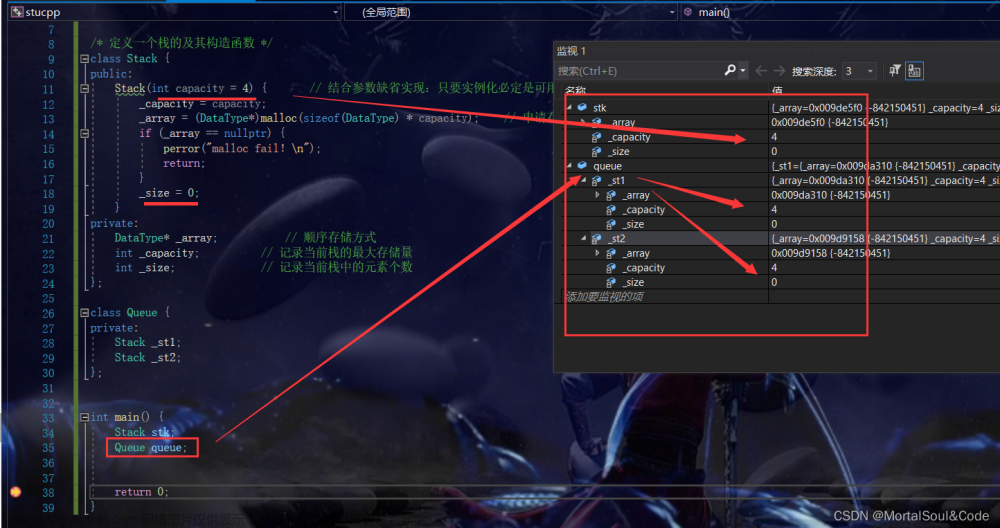使用编程语言进行编程时,需要用到各种变量来存储各种信息。变量保留的是它所存储的值的内存位置。这意味着,当您创建一个变量时,就会在内存中保留一些空间。
您可能需要存储各种数据类型(比如字符型、宽字符型、整型、浮点型、双浮点型、布尔型等)的信息,操作系统会根据变量的数据类型,来分配内存和决定在保留内存中存储什么。
基本的内置类型
C++ 为程序员提供了种类丰富的内置数据类型和用户自定义的数据类型。下表列出了七种基本的 C++ 数据类型:
| 类型 | 关键字 |
|---|---|
| 布尔型 | bool |
| 字符型 | char |
| 整型 | int |
| 浮点型 | float |
| 双浮点型 | double |
| 无类型 | void |
| 宽字符型 | wchar_t |
其实 wchar_t 是这样来的:
typedef short int wchar_t;
所以 wchar_t 实际上的空间是和 short int 一样。
一些基本类型可以使用一个或多个类型修饰符进行修饰:
- signed
- unsigned
- short
- long
下表显示了各种变量类型在内存中存储值时需要占用的内存,以及该类型的变量所能存储的最大值和最小值。
注意:不同系统会有所差异,一字节为 8 位。
注意:默认情况下,int、short、long都是带符号的,即 signed。
注意:long int 8 个字节,int 都是 4 个字节,早期的 C 编译器定义了 long int 占用 4 个字节,int 占用 2 个字节,新版的 C/C++ 标准兼容了早期的这一设定。
| 类型 | 位 | 范围 |
|---|---|---|
| char | 1 个字节 | -128 到 127 或者 0 到 255 |
| unsigned char | 1 个字节 | 0 到 255 |
| signed char | 1 个字节 | -128 到 127 |
| int | 4 个字节 | -2147483648 到 2147483647 |
| unsigned int | 4 个字节 | 0 到 4294967295 |
| signed int | 4 个字节 | -2147483648 到 2147483647 |
| short int | 2 个字节 | -32768 到 32767 |
| unsigned short int | 2 个字节 | 0 到 65,535 |
| signed short int | 2 个字节 | -32768 到 32767 |
| long int | 8 个字节 | -9,223,372,036,854,775,808 到 9,223,372,036,854,775,807 |
| signed long int | 8 个字节 | -9,223,372,036,854,775,808 到 9,223,372,036,854,775,807 |
| unsigned long int | 8 个字节 | 0 到 18,446,744,073,709,551,615 |
| float | 4 个字节 | 精度型占4个字节(32位)内存空间,+/- 3.4e +/- 38 (~7 个数字) |
| double | 8 个字节 | 双精度型占8 个字节(64位)内存空间,+/- 1.7e +/- 308 (~15 个数字) |
| long double | 16 个字节 | 长双精度型 16 个字节(128位)内存空间,可提供18-19位有效数字。 |
| wchar_t | 2 或 4 个字节 | 1 个宽字符 |
注意,各种类型的存储大小与系统位数有关,但目前通用的以64位系统为主。
以下列出了32位系统与64位系统的存储大小的差别(windows 相同):
从上表可得知,变量的大小会根据编译器和所使用的电脑而有所不同。
下面实例会输出您电脑上各种数据类型的大小。
实例
#include<iostream>
#include <limits>
using namespace std;
int main()
{
cout << "type: \t\t" << "************size**************"<< endl;
cout << "bool: \t\t" << "所占字节数:" << sizeof(bool);
cout << "\t最大值:" << (numeric_limits<bool>::max)();
cout << "\t\t最小值:" << (numeric_limits<bool>::min)() << endl;
cout << "char: \t\t" << "所占字节数:" << sizeof(char);
cout << "\t最大值:" << (numeric_limits<char>::max)();
cout << "\t\t最小值:" << (numeric_limits<char>::min)() << endl;
cout << "signed char: \t" << "所占字节数:" << sizeof(signed char);
cout << "\t最大值:" << (numeric_limits<signed char>::max)();
cout << "\t\t最小值:" << (numeric_limits<signed char>::min)() << endl;
cout << "unsigned char: \t" << "所占字节数:" << sizeof(unsigned char);
cout << "\t最大值:" << (numeric_limits<unsigned char>::max)();
cout << "\t\t最小值:" << (numeric_limits<unsigned char>::min)() << endl;
cout << "wchar_t: \t" << "所占字节数:" << sizeof(wchar_t);
cout << "\t最大值:" << (numeric_limits<wchar_t>::max)();
cout << "\t\t最小值:" << (numeric_limits<wchar_t>::min)() << endl;
cout << "short: \t\t" << "所占字节数:" << sizeof(short);
cout << "\t最大值:" << (numeric_limits<short>::max)();
cout << "\t\t最小值:" << (numeric_limits<short>::min)() << endl;
cout << "int: \t\t" << "所占字节数:" << sizeof(int);
cout << "\t最大值:" << (numeric_limits<int>::max)();
cout << "\t最小值:" << (numeric_limits<int>::min)() << endl;
cout << "unsigned: \t" << "所占字节数:" << sizeof(unsigned);
cout << "\t最大值:" << (numeric_limits<unsigned>::max)();
cout << "\t最小值:" << (numeric_limits<unsigned>::min)() << endl;
cout << "long: \t\t" << "所占字节数:" << sizeof(long);
cout << "\t最大值:" << (numeric_limits<long>::max)();
cout << "\t最小值:" << (numeric_limits<long>::min)() << endl;
cout << "unsigned long: \t" << "所占字节数:" << sizeof(unsigned long);
cout << "\t最大值:" << (numeric_limits<unsigned long>::max)();
cout << "\t最小值:" << (numeric_limits<unsigned long>::min)() << endl;
cout << "double: \t" << "所占字节数:" << sizeof(double);
cout << "\t最大值:" << (numeric_limits<double>::max)();
cout << "\t最小值:" << (numeric_limits<double>::min)() << endl;
cout << "long double: \t" << "所占字节数:" << sizeof(long double);
cout << "\t最大值:" << (numeric_limits<long double>::max)();
cout << "\t最小值:" << (numeric_limits<long double>::min)() << endl;
cout << "float: \t\t" << "所占字节数:" << sizeof(float);
cout << "\t最大值:" << (numeric_limits<float>::max)();
cout << "\t最小值:" << (numeric_limits<float>::min)() << endl;
cout << "size_t: \t" << "所占字节数:" << sizeof(size_t);
cout << "\t最大值:" << (numeric_limits<size_t>::max)();
cout << "\t最小值:" << (numeric_limits<size_t>::min)() << endl;
cout << "string: \t" << "所占字节数:" << sizeof(string) << endl;
// << "\t最大值:" << (numeric_limits<string>::max)() << "\t最小值:" << (numeric_limits<string>::min)() << endl;
cout << "type: \t\t" << "************size**************"<< endl;
return 0;
}
本实例使用了 endl,这将在每一行后插入一个换行符,<< 运算符用于向屏幕传多个值,sizeof() 运算符用来获取各种数据类型的大小。
当上面的代码被编译和执行时,它会产生以下的结果,结果会根据所使用的计算机而有所不同:
type: ************size************** bool: 所占字节数:1 最大值:1 最小值:0 char: 所占字节数:1 最大值: 最小值:? signed char: 所占字节数:1 最大值: 最小值:? unsigned char: 所占字节数:1 最大值:? 最小值: wchar_t: 所占字节数:4 最大值:2147483647 最小值:-2147483648 short: 所占字节数:2 最大值:32767 最小值:-32768 int: 所占字节数:4 最大值:2147483647 最小值:-2147483648 unsigned: 所占字节数:4 最大值:4294967295 最小值:0 long: 所占字节数:8 最大值:9223372036854775807 最小值:-9223372036854775808 unsigned long: 所占字节数:8 最大值:18446744073709551615 最小值:0 double: 所占字节数:8 最大值:1.79769e+308 最小值:2.22507e-308 long double: 所占字节数:16 最大值:1.18973e+4932 最小值:3.3621e-4932 float: 所占字节数:4 最大值:3.40282e+38 最小值:1.17549e-38 size_t: 所占字节数:8 最大值:18446744073709551615 最小值:0 string: 所占字节数:24 type: ************size**************
typedef 声明
您可以使用 typedef 为一个已有的类型取一个新的名字。下面是使用 typedef 定义一个新类型的语法:
typedef type newname;
例如,下面的语句会告诉编译器,feet 是 int 的另一个名称:
typedef int feet;
现在,下面的声明是完全合法的,它创建了一个整型变量 distance:
feet distance;
枚举类型
枚举类型(enumeration)是C++中的一种派生数据类型,它是由用户定义的若干枚举常量的集合。
如果一个变量只有几种可能的值,可以定义为枚举(enumeration)类型。所谓"枚举"是指将变量的值一一列举出来,变量的值只能在列举出来的值的范围内。
创建枚举,需要使用关键字 enum。枚举类型的一般形式为:
enum 枚举名{
标识符[=整型常数],
标识符[=整型常数],
...
标识符[=整型常数]
} 枚举变量;
如果枚举没有初始化, 即省掉"=整型常数"时, 则从第一个标识符开始。
例如,下面的代码定义了一个颜色枚举,变量 c 的类型为 color。最后,c 被赋值为 "blue"。
enum color { red, green, blue } c;
c = blue;
默认情况下,第一个名称的值为 0,第二个名称的值为 1,第三个名称的值为 2,以此类推。但是,您也可以给名称赋予一个特殊的值,只需要添加一个初始值即可。例如,在下面的枚举中,green 的值为 5。
enum color { red, green=5, blue };
在这里,blue 的值为 6,因为默认情况下,每个名称都会比它前面一个名称大 1,但 red 的值依然为 0。
类型转换
类型转换是将一个数据类型的值转换为另一种数据类型的值。
C++ 中有四种类型转换:静态转换、动态转换、常量转换和重新解释转换。
静态转换(Static Cast)
静态转换是将一种数据类型的值强制转换为另一种数据类型的值。
静态转换通常用于比较类型相似的对象之间的转换,例如将 int 类型转换为 float 类型。
静态转换不进行任何运行时类型检查,因此可能会导致运行时错误。
实例
int i = 10;
float f = static_cast<float>(i); // 静态将int类型转换为float类型
动态转换(Dynamic Cast)
动态转换通常用于将一个基类指针或引用转换为派生类指针或引用。动态转换在运行时进行类型检查,如果不能进行转换则返回空指针或引发异常。
实例
class Base {};
class Derived : public Base {};
Base* ptr_base = new Derived;
Derived* ptr_derived = dynamic_cast<Derived*>(ptr_base); // 将基类指针转换为派生类指针
常量转换(Const Cast)
常量转换用于将 const 类型的对象转换为非 const 类型的对象。
常量转换只能用于转换掉 const 属性,不能改变对象的类型。
实例
const int i = 10;
int& r = const_cast<int&>(i); // 常量转换,将const int转换为int
重新解释转换(Reinterpret Cast)
重新解释转换将一个数据类型的值重新解释为另一个数据类型的值,通常用于在不同的数据类型之间进行转换。
重新解释转换不进行任何类型检查,因此可能会导致未定义的行为。文章来源:https://www.toymoban.com/news/detail-583748.html
实例
int i = 10;
float f = reinterpret_cast<float&>(i); // 重新解释将int类型转换为float类型文章来源地址https://www.toymoban.com/news/detail-583748.html
到了这里,关于C++ 数据类型的文章就介绍完了。如果您还想了解更多内容,请在右上角搜索TOY模板网以前的文章或继续浏览下面的相关文章,希望大家以后多多支持TOY模板网!












